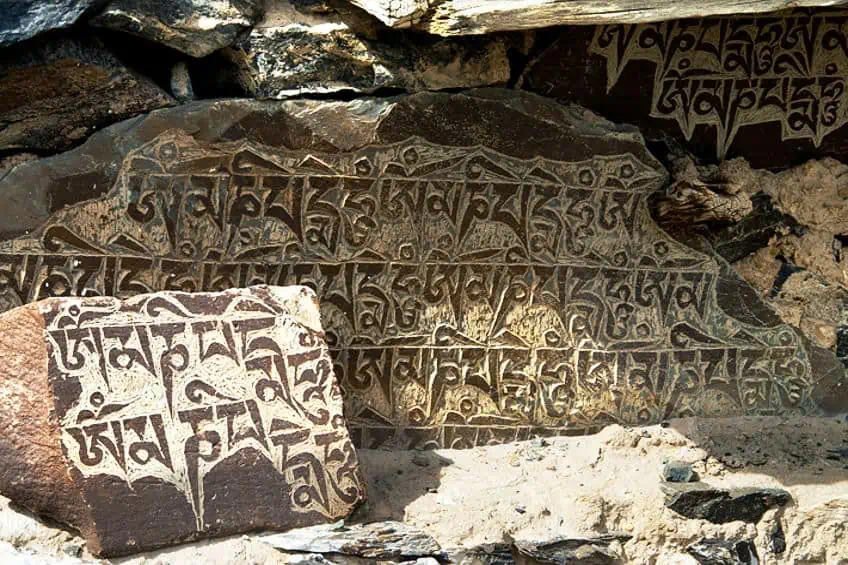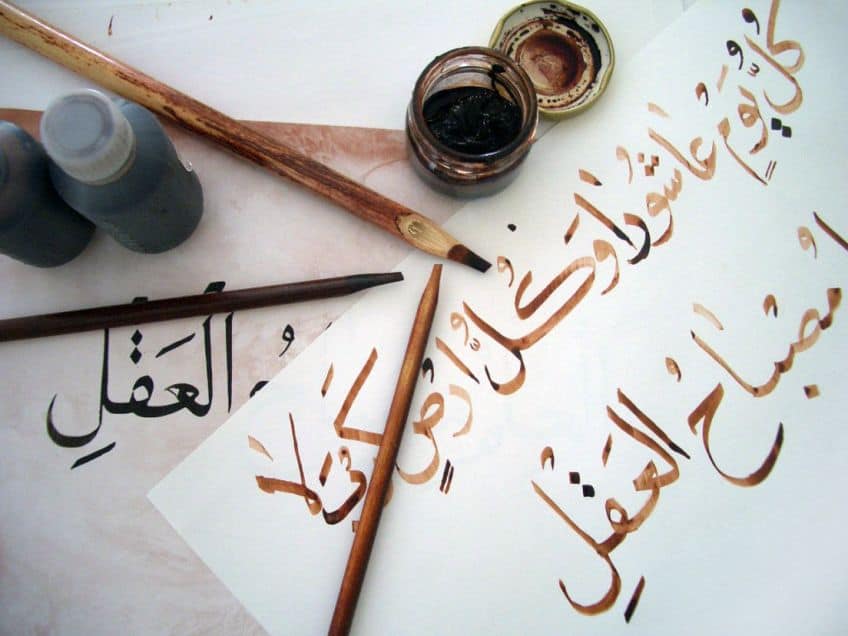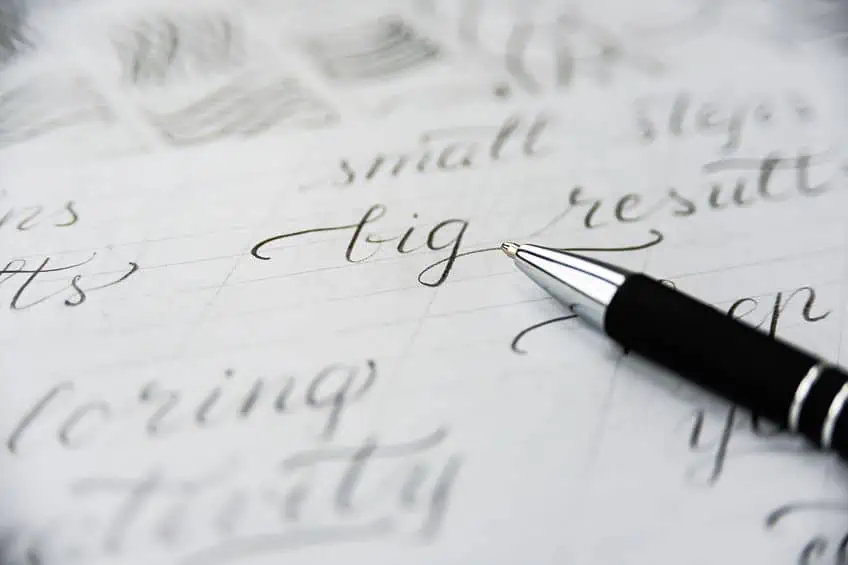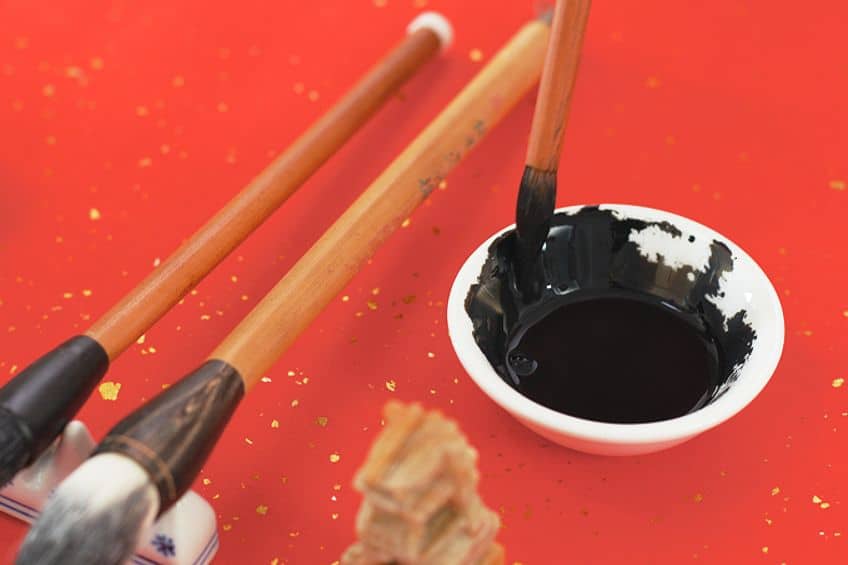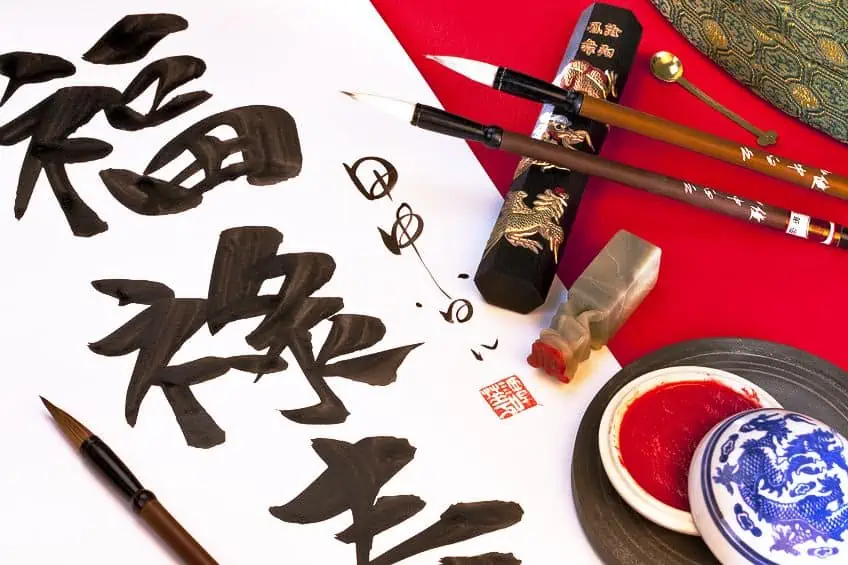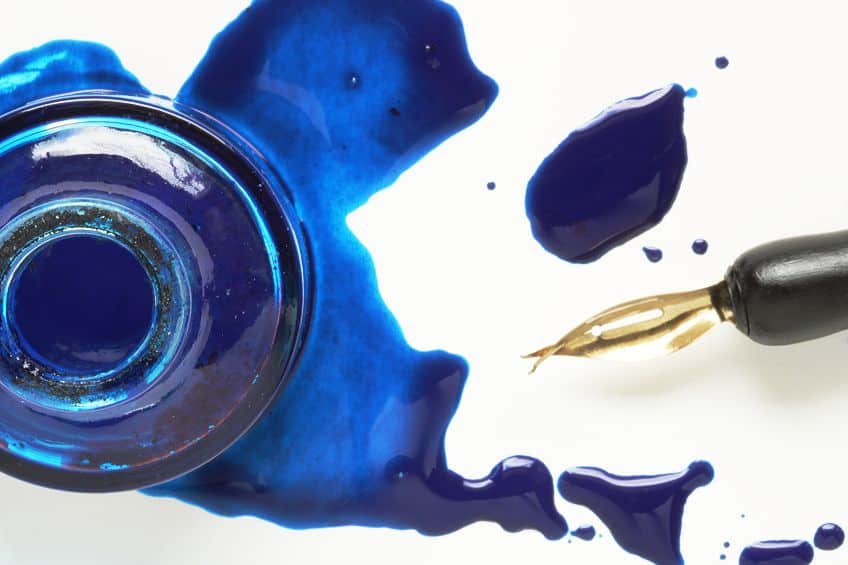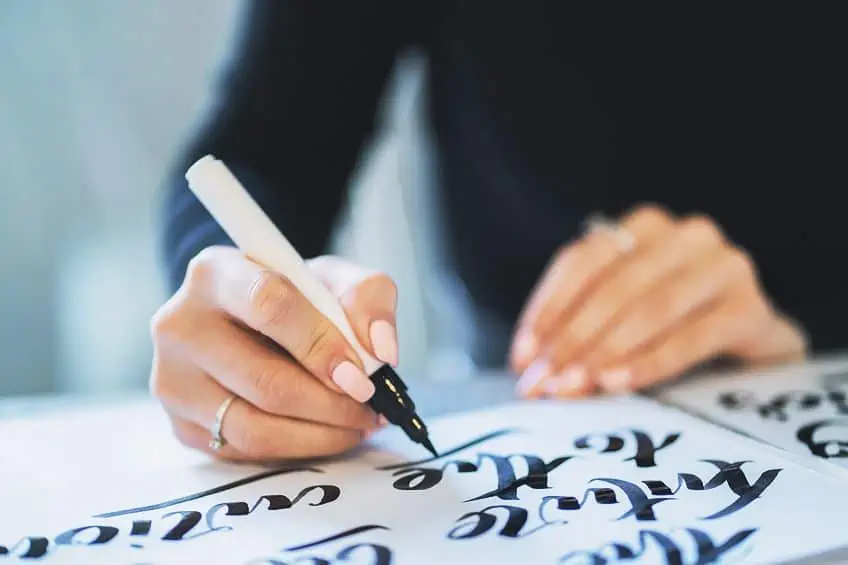What Is Calligraphy? – Learn the Art of Calligraphy Writing
Calligraphy has existed in some form in almost every civilization, but have you ever wondered what is calligraphy exactly? Below, we explore the history of calligraphy, the different types, and styles, as well as how its uses and definition have evolved over time with the advancement of technologies and techniques.
What Is Calligraphy?
The term calligraphy stems from two Greek words: “kallos” which means “beauty”, and “graphein” which means “to write”. However, calligraphy has evolved to be more than just beautiful penmanship, it is an artistic skill. The main goal of handwriting is to be quick and legible. The goal of calligraphy is different from this and aims to create words that have an artistic impact and are aesthetically pleasing. So, you can see, calligraphy is not simply fancy handwriting as speed and clarity are not important. Calligraphy is also distinct from lettering, which focuses on drawing individual letters in aesthetic ways irrespective of forming words.
Calligraphy involves the creation and arrangement of symbols by hand by using specific strokes to form each letter.
This must be done in a way that is proportionate, harmonious, reflective of the heritage of calligraphy, and creates a feeling of a rhythmic pattern. Calligraphy also includes the unique personal flair of the calligrapher, which is what clearly defines this as an art form rather than elaborate penmanship. Just like other art forms, calligraphy aims to evoke feelings and emotions, however, it communicates its message using both visual and linguistic channels.
History of Calligraphy
Throughout history, every single civilization has had some unique form of calligraphy. Both creative and functional purposes using various tools. Modern day calligraphy takes inspiration from the deep and rich history of calligraphy that came before it. The exact origin of calligraphy is still debated; however, many experts believe it may have originated around 1200 B.C.E. among the Phoenicians. The Ancient Greeks then took up the practice and later passed it to the Ancient Romans who spread it as their empire expanded. Calligraphy in this region was largely based on the Latin alphabet and was shaped through the Middle Ages and Renaissance. It then went on to form the basis of Western Calligraphy today.
A different variation of calligraphy also emerged in Asian regions, specifically during the Shang Dynasty of China.
It began with ideographs and pictograms made on the surface of bones or jade. This form of calligraphy was created for the writing characters of the region rather than the letters used in the Latin alphabet. Calligraphy continued to grow and became especially common throughout the Han dynasty as educated men and women had to show proficiency at it. Calligraphy in the past was primarily used in almost all regions to record religious texts or important historical events.
Modern Era of Calligraphy
The invention of the printer and computer in the 15th and 20th respectively affected calligraphy greatly and decreased its need for and importance. People could now have anything they needed, printed out quicker and for less money. As printers and computers became more widespread and text and emails were invented, the need for handwritten records and letters have all but been eliminated. The need for art and beauty, however, has not been eliminated.
This means that calligraphy has still survived the years despite these impacts and has become an art form that is still sought after today.
Calligraphy found renewed popularity towards the end of the 19th century and is used to create both functional and decorative pieces today. This revival was spearheaded by William Morris and Edward Johnston who began teaching the art form. Edward Johnston also designed typefaces, many of which are still in use today, and is largely responsible for the revival of artistic penmanship and lettering.
Key Characteristics of Modern Calligraphy
One of the key distinctions of modern calligraphy is that it is not always intended to be legible, which is a large diversion from historical uses. This is largely due to the influence and popularity of abstract art in the 20th century. This also led to calligraphy becoming popular among graffiti artists as both art forms involve stylized lettering. Two of the most well-known graffiti calligraphers are El Seed and Niels Shoe Meulman.
Calligraphy Styles
As mentioned earlier, each civilization has some form of calligraphy, however, certain regions have been more influential. Four of the most prominent calligraphy styles today are Islamic Calligraphy, Western Calligraphy, South Asian Calligraphy, and East Asian Calligraphy. Each one of these types of calligraphy has its own unique history, rules, and characters; however, they have also influenced each other.
While these are the dominant calligraphy styles today, there are many other regions that have striking forms of calligraphy including African communities such as Egypt and Ethiopia, Southeast Asian communities such as the Philippines and Vietnam, as well as Eastern European communities such as the Slavonic regions.
Islamic Calligraphy
Islamic calligraphy comprises lettering from Persian, Arabic, Ottoman, and Urdu script and forms a crucial component of Islamic art and culture. This calligraphy style was developed alongside Islamic religion and the Arabic language and therefore is often found on mosque walls or in religious artworks. Islamic Calligraphy is characterized by geometric designs and is often considered one of the most beautiful forms of lettering. Calligraphy is viewed as the highest form of artistic expression in Muslim communities as it is considered the most efficient way of communing with the spiritual world. Calligraphy is even valued as a moral good in some regions, as beautiful and “pure” writing is said to lead to a pure soul.
Islamic Calligraphy is not only limited to religious works, however, and includes a variety of subjects and objects.
Tools used to create Islamic calligraphy include the kalam, which is a pen traditionally made of bamboo or dried reeds, or a metallic-tip pen. The inks used in this calligraphy style are often vibrant in color, although some more muted colors are also used to create a sense of depth and movement within the pieces. Islamic Calligraphy has been created on a multitude of surfaces including paper, papyrus, tiles, parchment, carpets, vessels, and stone.
Islamic Calligraphy Styles
There are five primary styles in Islamic Calligraphy, namely Kufic, Naskh, Thuluth, Reqā, Muhaqqaq. Kufic is a rigid and linear style developed around the 7th century and is characterized by very angular strokes. Because of this, it is often used for stone carving or to decorate coins. Naskh was developed around the same time as Kufic, however, has more rounded and smaller strokes when compared to Kufic calligraphy. The Naskh calligraphy style formed the basis of modern-day Arabic print and is the standard style used for transcribing books and manuscripts. Thuluth was developed after Kufic and Naskh around the 15th century and went on to be refined by Ottoman calligraphers.
This style is characterized by extended vertical lines with wide spacing.
Reqā was developed five centuries later and is similar in style to Thuluth, however, uses much shorter strokes as well as small flourishes. A variation of Thuluth, Muhaqqaq is a truly magnificent style that is used by experienced calligraphers. Both Muhaqqaq and Thuluth are widely considered the most beautiful calligraphy scripts, and some of the most challenging to execute. As with almost all forms of calligraphy, many of these styles have been altered by modern artists and influences from around the world.
Western Calligraphy
Western Calligraphy is arguably one of the most recognizable forms of calligraphy thanks to its popularity and distinctive style. This style has defined rules and, like Islamic Calligraphy, makes heavy use of geometric patterns. Despite its emergence during the 10th century, Western Calligraphy continues to change and develop to this day. Latin script is one of the most recognizable uses of this kind of calligraphy and saw many changes and alterations as different dynasties came and went. The Renaissance, the English script, and Batarde of the 17th century were major influences on this type of Calligraphy.
Tools used to create Western Calligraphy include brushes, various ink pens including pointed- or flat-nibbed pens, water-based ink, as well as parchment or paper. A knife is also often used to remove move work and templates.
Western Calligraphy Styles
The two main varieties of Western Calligraphy include traditional and modern calligraphy. Traditional calligraphy styles were developed around 600 B.C.E and are based on the old Latin script. They follow strict rules for how to form and space each letter. Modern calligraphy styles break away from many of these traditional rules to allow for more creative freedom, however, do still retain some of the rules surrounding letter formation.
South Asian Calligraphy
South Asian Calligraphy is one of the most ancient forms of lettering found. Southern Asian Calligraphy comprises lettering from Nepal, Tibet, and India. Like Islamic Calligraphy, South Asian Calligraphy is widely used for secular purposes as well as for many aspects of Buddhism practices including messages to the Dalai Lama and on prayer wheels. South Asian Calligraphy, particularly Tibetan calligraphy, has also been inscribed on buildings and within art much like Western and Arabic Calligraphy.
Indian calligraphy has had one of the largest impacts on South Asian Calligraphy and has been created using many instruments throughout history, including copper, burnt mud, birch bark, and smoked palm trees.
Tibet is used primarily with Buddhism and is frequently used in important religious writings and written words within the practice. Tibetan calligraphy was historically created using reeds, however, today it is created primarily using chisel-tipped marker pens and other calligraphy pens.
East Asian Calligraphy
Eastern Asian Calligraphy comprises lettering from Japan, Korea, and China. Like with other forms of calligraphy, every civilization in these regions have all contributed to the unique style of East Asian Calligraphy. Unlike Western Calligraphy, East Asia Calligraphy is based on symbols rather than letters. These symbols convey the same meaning as entire words that would normally be used in Western Calligraphy and because of this, Eastern Asian Calligraphy manuscripts are often much shorter. This type of calligraphy has important historical and modern-day value to the countries and continues to play an important role in East Asian culture. These countries actively work to preserve ancient calligraphy practices and its history.
Japanese calligraphy is known locally as shodō, Korean calligraphy is locally called seoye, and Chinese calligraphy as shūfǎ or fǎshū.
Chinese calligraphy has had a major influence on Korean and Japanese calligraphy; however, these types of calligraphy still maintain their own unique techniques and styles of calligraphy. Traditional East Asian calligraphy styles make use of four key tools: Chinese ink, máobǐ ink brushes, inkstones, and paper, which are locally known as the Four Treasures of the Study. Eastern Asian Calligraphy also makes use of desk pads and paperweights, and more contemporary artists use Western Calligraphy tools as well.
Basic Tools and Materials Used in Calligraphy
Calligraphy is an art form that focuses on the skill of the artists and uses only a few simple tools. There are only three basic tools used to create calligraphy: ink, paper, and a writing tool such as a pen or brush. There are many varieties of each of these tools at different price points, for different experience levels and that can be used to create different effects, which makes calligraphy a very flexible art medium.
Pens and Brushes for Calligraphy
The most important tool used in calligraphy is the pen or brush. A calligraphy pen or brush is used to apply your ink to the writing surface, therefore the type of pen or brush you use will have a large impact on the ease and final look of your calligraphy. Calligraphy brushes tend to have a cone-shaped tip, ending in a fine point, which allows the artist to produce lines of varying thicknesses. There are a variety of pen tips or nibs used in calligraphy including rounded, pointed, or flat. Some artists even create calligraphy with felt-tipped pens; however, these works tend to lack angled lines or be faux calligraphy, which adds additional strokes to achieve the look.
Brush pens are also a popular choice for calligraphy especially for beginners, as they offer a lot of control and give you the added benefit of not having to load up your pen. The more common types of calligraphy brushes and pens include:
- Ink brush
- Dip pen
- Fountain pen
- Quill
- Qalam
- Chiseled marker
Inks for Calligraphy
There are different inks for different pens and effects, meaning that there is no best ink. Inks for calligraphy can be broadly categorized into inks for dip pens and ink for fountain pens. Ink for fountain pens are waterproof, which ensures that the flow of ink does not become obstructed if the ink dries in the feed mechanism. They come in dye-based and pigment-based varieties. Pigment-based inks are much more lightfast than dye-based inks, which tend to fade when exposed to light. You should always refer to your pen’s manufacturing specifications when determining which fountain pen ink is right for you.
Dips pens can be used with a larger variety of inks than fountain pens, including acrylic, carbon, and gouache ink. Carbon-based inks are more resistant to fading than most other inks, while water-based acrylic inks are less viscous and have easier flow.
Instead of dipping the pen in the ink like the name implies, it is better to load the pen with a dropper or small brush as this gives you greater control over the amount of ink on your pen. Chinese or Japanese stick ink are also used in dip pens. These inks can take some practice to use correctly but offer greater control over ink thickness and consistency. To use an ink stick, a small amount of water is placed on a special ink stone and the ink stick is slowly grounded and mixed with the water until the desired consistency is achieved.
Paper for Calligraphy
A good calligraphy paper will result in calligraphy that has clean lines and is resistant to ink pooling or smudging. Paper that is used for calligraphy should have an even surface with a consistent texture. The paper should also be able to readily absorb the ink from your writing tool. Besides traditional calligraphy paper, parchment paper and vellum are also used as it allows you to easily remove mistakes by peeling them off with a knife.
Paper that is slightly translucent is also great to use for calligraphy as it allows templates to show through, making it easier to achieve straight lines without the need for pencil markings.
When you are starting out, ruled calligraphy paper is an excellent tool for perfecting your spacing. This type of paper has ruled horizontal, ascender, and descender lines usually every quarter or half inch to serve as a guideline for your calligraphy. Some varieties even have diagonal lines called slant lines to assist with drawing your angled lines as well.
Tips for Learning Calligraphy
While calligraphy may seem daunting and complicated at first, anyone can learn how to do it once you understand the basics. If you are a beginner, there are a few key things that you can focus on to improve your calligraphy and avoid simple mistakes.
Understanding the Strokes
When you look closely at calligraphy, you can see that it is created using only a handful of strokes and shapes that are repeated to create the distinct letters and words. In calligraphy, each letter is made up of a series of up-strokes and down-strokes where up-strokes are generally thin while down-strokes are thick. Familiarize yourself first with the up- and down-strokes needed to form each letter as well as how your writing tool creates them.
Copying historical handwriting is a great way to learn different letters and calligraphy techniques.
So long as you do not attempt to pass off others’ work as your own, copying from historical or modern examples can be a great learning tool. A pencil is also a good tool to use to practice your calligraphy as it allows you to create thick and thin lines with varying pressure, just as with a calligraphy brush or pen.
Handling Your Calligraphy Pen
One of the biggest difficulties that beginners face with calligraphy is how to hold their calligraphy pen correctly. When creating calligraphy, your pen should be kept at a 45° angle to your writing surface instead of the more upright angle that many people normally write with. By holding your pen too upright, you not only run the chance of damaging its tip, but you also cannot create the characteristic thin and thick strokes of calligraphy. This is especially important when you are using dip pens as the angle allows the tip to open up more on a down-stroke, creating a thicker line, and prevents the tip from digging into the page on the up-stroke when you are drawing thinner lines.
You should also experiment with different quantities of ink loaded onto your dip pen to find what works best for you.
If you are using fountain pens, dye-based inks are thinner and have a more consistent flow and therefore may be easier to start with. If you are having trouble managing the flow of ink and creating strokes with both pens, consider learning the basics with a brush pen instead and trying them again once you are more confident.
Creating Consistency in Your Calligraphy
The two most important aspects of creating calligraphy that is harmonious and aesthetically pleasing are ensuring consistency in your lettering and spacing. Consistency in lettering includes ensuring that the height, width, and angles of your letters are all the same throughout the piece. This consistency is easily achieved by using a pencil to create guidelines or using pre-ruled calligraphy paper. The aim of consistency is not perfection or the elimination of creative freedom, but rather brings a uniform and pleasing look to your work.
Consistency in spacing involves ensuring that the spaces between your letters are even and equal.
In addition to improving the uniformity of your letters, this also increases the legibility of your words and ensures that you do not cram your letters together at the end. Good spacing takes practice and patience as you will need to work slowly while paying attention to the spaces between your letters and matching them.
Different Applications of Calligraphy
Now that you know more about calligraphy you may be wondering “how is calligraphy used as an art form?” Calligraphy has a multitude of uses across many different fields, from decorative and artistic to personal and everyday use.
What Is Calligraphy Used for in Art and Design?
Calligraphy continues to be used in religious art and design today, as it was in the past. It is also a favored method of inscribing stone and other hard materials. Since the widespread use of the printer, calligraphy is more commonly used for special occasions such as in wedding and event invitations. Calligraphy is also used to give a classical feeling to book cover designs, maps, and logo designs. Calligraphy not only makes these designs stand apart from today’s minimalistic trends, but also makes them appealing to the eye and encourages the customer to spend longer reading them.
Calligraphy also inspires many unique and alternative artistic practices, such as tattooing or even artists on social media.
What Is Calligraphy Used for in Everyday Life?
Many calligraphers also use calligraphy for more everyday activities. Today, the most common use of calligraphy is on your important documents. Government, schools, and businesses all make use of calligraphy to give certificates and awards an air of elegance and distinction. Awards, marriage, birth, and death certificates, as well as university degrees usually make use of calligraphy in some form.
Many calligraphers have made businesses out of calligraphy commissions, particularly for creating custom envelopes or adding beautiful writing on surfaces that are difficult or impossible to print onto.
Calligraphy is often used purely as a creative outlet or to create a personalized gift for friends and family such as cards, keyrings, or decorated pots for houseplants. Calligraphy also provides artists with many personal benefits such as a way of improving your creativity, concentration, and handwriting.
From decorative embellishments to spiritually powerful practices, calligraphy has evolved across many diverse centuries and cultures across the globe. In this article, we covered some of the most common forms of calligraphy, but there are many other varieties out there. Calligraphy is a versatile art form which anyone can use to create striking pieces with some practice and patience!
Frequently Asked Questions
What Is Calligraphy?
Calligraphy is the art of producing beautiful writing using an arrangement of specific strokes to produce something artistic and impactful.
What Are Popular Calligraphy Styles?
There are four main varieties of calligraphy today, each with their own distinct calligraphy styles. These are Islamic calligraphy, Western calligraphy, South Asian calligraphy, and East Asian calligraphy.
How Is Calligraphy Used as an Art Form?
Calligraphy is often used in religious artworks and in the design of book covers and business logos. Calligraphy is also commonly used to adorn official documents from government and educational institutions, as well as for special event invitations such as weddings and birthdays.
Liam Davis is an experienced art historian with demonstrated experience in the industry. After graduating from the Academy of Art History with a bachelor’s degree, Liam worked for many years as a copywriter for various art magazines and online art galleries. He also worked as an art curator for an art gallery in Illinois before working now as editor-in-chief for artfilemagazine.com. Liam’s passion is, aside from sculptures from the Roman and Greek periods, cave paintings, and neolithic art.
Learn more about Liam Davis and about us.
Cite this Article
Liam, Davis, “What Is Calligraphy? – Learn the Art of Calligraphy Writing.” artfilemagazine – Your Online Art Source. August 21, 2023. URL: https://artfilemagazine.com/what-is-calligraphy/
Davis, L. (2023, 21 August). What Is Calligraphy? – Learn the Art of Calligraphy Writing. artfilemagazine – Your Online Art Source. https://artfilemagazine.com/what-is-calligraphy/
Davis, Liam. “What Is Calligraphy? – Learn the Art of Calligraphy Writing.” artfilemagazine – Your Online Art Source, August 21, 2023. https://artfilemagazine.com/what-is-calligraphy/.





